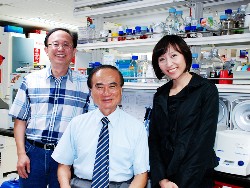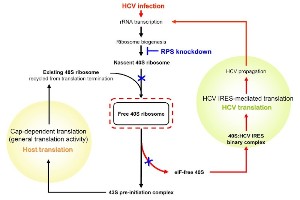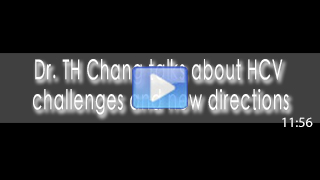 Research Team:Dr. Tien-Hsien Chang, Dr. Michael M.C. Lai, research assistant Jing-Ying Huang(from left to right)
Research Team:Dr. Tien-Hsien Chang, Dr. Michael M.C. Lai, research assistant Jing-Ying Huang(from left to right)
By pushing the boundaries and thinking out of the box, Dr. Tien-Hsien Chang demonstrates once again what a scientific spirit is all about.
Hepatitis C Virus (HCV) is a blood-transmitted virus that has infected roughly two percent of the world’s population. So far, there is no effective vaccine to prevent HCV transmission. If not cured completely, HCV-infected patients risk developing liver cirrhosis or liver cancer later in life. Currently, the one way to treat HCV infection is by using a combination of interferon and ribavirin. However, the cure rate is less than 50% for some HCV strains.
Traditionally, most, if not all, the antivirals are designed to inhibit or block the activities of specific viral proteins. From past experience, though, we are almost certain that these drugs will ultimately lose their efficacy due to emergence of drug-resistant mutant viral strains.
|
Video clips of Dr. Chang explaining the Science: 1. Dr. TH Chang talks about HCV challenges and new directions 2. The 40s Ribsome subunit regulation strategy |
Are we doomed to give in? “Not I.” Said Dr. Michael Lai.
Dr. Michael M.C. Lai, an adjunct researcher of GRC, is a world renowned scientist in studying the mechanisms of replication and pathogenesis of several medically important RNA viruses. In searching for better ways to combat HCV, he applied an alternative strategy for exploring the genetic stability of host factors essential for HCV replication. He led a research group using RNAi technology to systematically search for key cellular elements that HCV must borrow from the cell to successfully reproduce itself.
From such a screen, the 40S subunit of ribosome rose up to the top of a list of potential targets. Ribosomes are essential cellular machines responsible for making proteins and used also by viruses to make their own proteins. Because the 40S subunit is such a fundamental element, removing it is akin to getting rid of the life and blood of the cell. When there is no viable cell, there is thus no virus. This is unsurprising, making this finding seemingly meaningless.
However, when Dr. Tien-Hsien Chang joined the group and pondered more with Dr. Lai and Jing-Ying Huang, a research associate who is responsible for executing the project, he suggested an alternative hypothesis from an entirely different perspective. Chang reasoned that under normal conditions there may be plenty of ribosomal 40S subunit, thus enabling both cell and HCV to happily make their own proteins. As a result, HCV can co-exist with the cell and have a chance to thrive. Well, what if the amount of 40S subunit is not as much and the cell and the HCV now must compete for it? Will the HCV lose to the host cell?
After a series of carefully designed experiments, Chang’s unconventional theory appears to be correct. It turned out that, when the amount of 40S ribosomal subunit was experimentally reduced to half of its original quantity, the host cell remains essentially healthy and the level of HCV in the cell is reduced to only 10%, or lower.
 The abundance of free 40S ribosomal subunit differentially affects the translations of host and HCV
The abundance of free 40S ribosomal subunit differentially affects the translations of host and HCV
The eukaryotic ribosomal 40S subunit has been perfected over billions of years through evolution. As such, it is extremely unlikely to morph or mutate as freely as viruses. Therefore, finding a good way to fine-tune the 40S ribosomal subunit level as part of the therapeutics may be feasible, which Dr. Chang plans to pursue.
The research result has been published on the June 2012 issue of PLoS PATHOGENS, and a follow up report was done by A-IMBN RESEARCH, a publication which is jointly produced by the Asia-Pacific International Molecular Biology Network (A-IMBN) and NPG Nature Asia-Pacific. See: http://www.natureasia.com/A-IMBN/article.php?id=663

